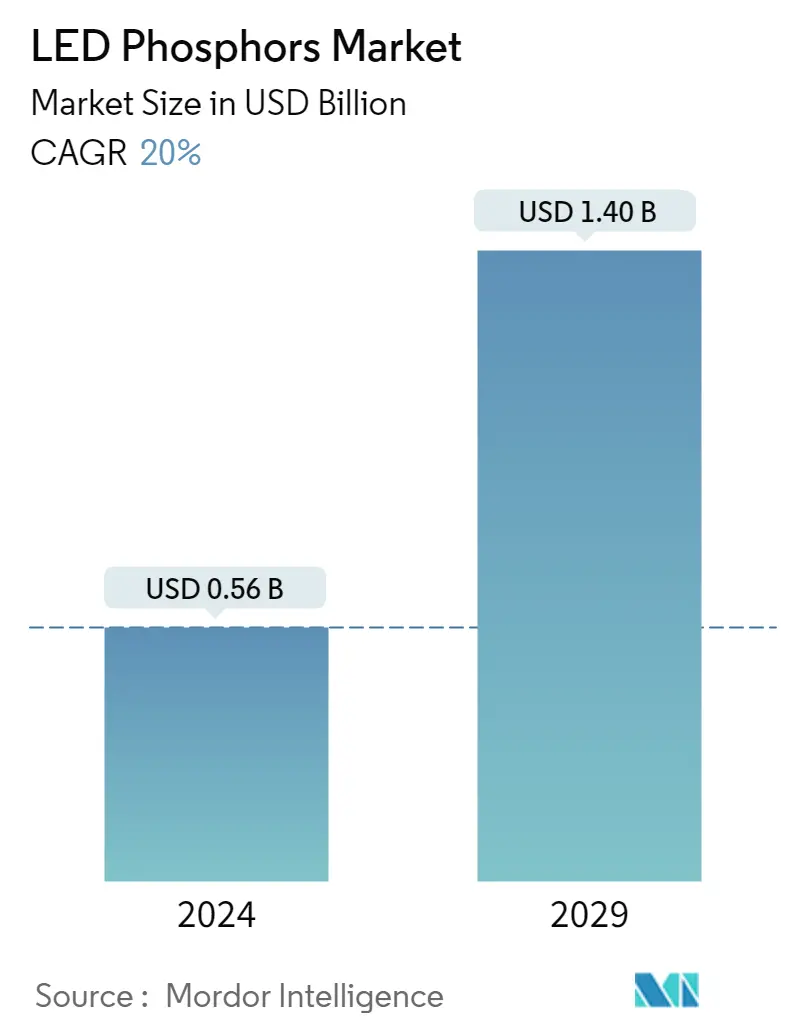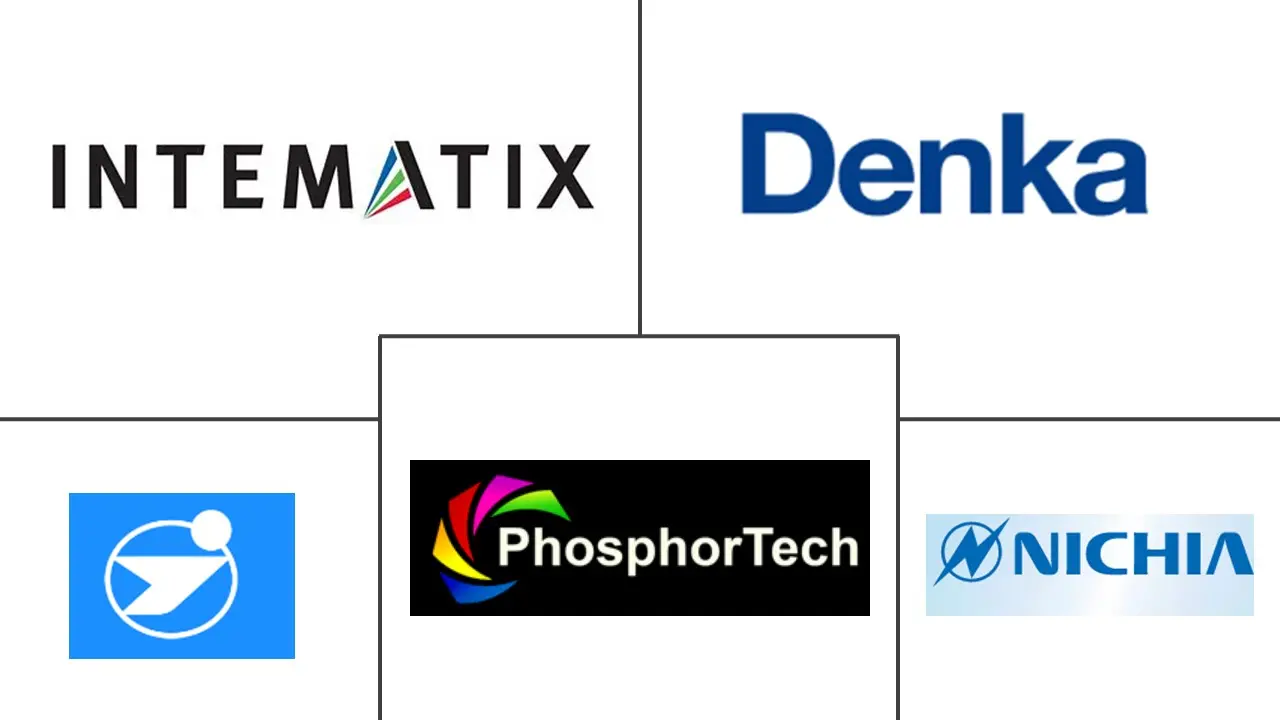Market Size of LED Phosphors Industry

| Study Period | 2019 - 2029 |
| Market Size (2024) | USD 0.56 Billion |
| Market Size (2029) | USD 1.40 Billion |
| CAGR (2024 - 2029) | 20.00 % |
| Fastest Growing Market | Asia Pacific |
| Largest Market | Asia-Pacific |
Major Players
*Disclaimer: Major Players sorted in no particular order |
LED Phosphors Market Analysis
The LED Phosphors Market size is estimated at USD 0.56 billion in 2024, and is expected to reach USD 1.40 billion by 2029, growing at a CAGR of 20% during the forecast period (2024-2029).
The growing preference for LED lighting technologies over conventional lighting systems is one of the primary factors driving the market's growth. Additionally, the increasing popularity of white LEDs has further propelled the market growth.
- LED phosphors are crucial materials in the manufacture of white LEDs. Phosphor composition largely determines an LED's efficiency, light quality, and stability. White LEDs are generally a combination of a blue light-emitting indium gallium nitride die and phosphor, which takes blue light and then converts it into a broad-spectrum peaking at yellow or amber.
- Government regulations mandating the use of LEDs are accelerating the demand in the market studied in several regions. For instance, in the United States, as the law requires energy savings to be 45 lumens per watt for the common types of light bulbs, a 60-watt incandescent light bulb can put out around 15 lumens per watt; a halogen incandescent bulb offers around 20 lumens per watt; CFL bulb provides 65 lumens per watt; LEDs put out 80 to 100 lumens per watt with a fraction of energy.
- Materials scientists at FEFU (Far Eastern Federal University), in partnership with an international research team, advanced the invention of composite ceramic materials (Ce3+:YAG-Al2O3), i.e., solid-state light converters (phosphors) that can be used in ground and aerospace technologies. LED systems based on molded materials can preserve 20-30% more energy than commercial analogs. According to the photonics development roadmap run in Russia, the development of LED technology with an efficiency of more than 150 lm/W would allow for savings of up to 30% in electricity by 2025.
- While developing phosphors LED smart lighting hardware components, there is an additional cost associated with this part of the project. Even though the price for hardware components has been dropping over the last few years, this element remains one of the essential factors in estimating the final price of the smart lighting project. In a smart lighting ecosystem, hardware contains several important elements, sometimes enhanced by additional components, such as light sources and sensors. The backend part of the smart lighting solution consumes at least 2,000 hours of development teamwork, and its price starts at USD 60,000.
LED Phosphors Industry Segmentation
A phosphor is a material that produces bright light when it comes into contact with infrared, ultraviolet radiation, or an electron beam source. In order to satisfy some of the performance criteria, a phosphor structure and composition may be carefully tuned so as to obtain an appropriate spectral content. Therefore, phosphors are frequently used in the electronics and lighting industry so that applications like e.g., displays, fluorescent lights, or blue LEDs can be achieved. Most white LEDs consist of a chip that emits Blue light with a narrow spectrum from 440 to 470 nm and is covered by either yellow, green, or red phosphors. Some of the blue light from that LED die is to be absorbed by phosphors. The phosphor light creates a white light, which is perceived by the human eye as blue, in addition to the remaining blue light that leaks out of the phosphor layer.
The LED phosphors market is segmented by applications (smartphones, LCD TVs, laptops, and tablets), automotive, lighting (residential and industrial), and geography (North America, Europe, Asia Pacific, and the Rest of the World).
The market sizes and forecasts are provided in terms of value in USD for all the above segments.
| By Application | |
| Smartphones | |
| LCD TVs | |
| Laptops/Tablets | |
| Automotive | |
| Lighting (Residential and Industrial) | |
| Other Applications |
| By Geography | |
| North America | |
| Europe | |
| Asia | |
| Australia and New Zealand | |
| Latin America | |
| Middle East and Africa |
LED Phosphors Market Size Summary
The LED phosphors market is experiencing significant growth, driven by the increasing preference for LED lighting technologies over traditional systems. This shift is largely due to the superior efficiency, light quality, and stability offered by LED phosphors, which are essential in the production of white LEDs. The market is further propelled by the rising popularity of white LEDs, which combine blue light-emitting indium gallium nitride dies with phosphors to create a broad-spectrum light. Government regulations mandating energy-efficient lighting solutions are also contributing to market expansion, as seen in regions like the United States, where stringent energy-saving laws are in place. Innovations in phosphor materials, such as those developed by researchers at Far Eastern Federal University, are enhancing the energy efficiency of LED systems, making them more appealing for both ground and aerospace applications.
The Asia-Pacific region is poised for substantial growth in the LED phosphors market, fueled by the expansion of consumer electronics and supportive government policies promoting energy-efficient lighting. Countries like India and China are at the forefront of this growth, with India benefiting from infrastructure development and government initiatives, while China's dual carbon policy encourages the adoption of LED technology to meet environmental targets. The market is characterized by a fragmented landscape with key players like Beijing Yuji International Co. Ltd, Intematix Corporation, and Nichia Corporation, who are actively engaging in partnerships and acquisitions to strengthen their market position. Recent developments, such as the opening of Signify's largest LED lighting manufacturing site in China and Samsung's unveiling of innovative Micro LED displays, highlight the ongoing advancements and competitive dynamics within the industry.
LED Phosphors Market Size - Table of Contents
-
1. MARKET INSIGHTS
-
1.1 Market Overview
-
1.2 Industry Attractiveness - Porter's Five Forces Analysis
-
1.2.1 Bargaining Power of Suppliers
-
1.2.2 Bargaining Power of Buyers
-
1.2.3 Threat of New Entrants
-
1.2.4 Threat of Substitute Products
-
1.2.5 Degree of Competition
-
-
1.3 Industry Value Chain Analysis
-
1.4 Assessment of the Impact of COVID-19 on the Industry
-
-
2. MARKET SEGMENTATION
-
2.1 By Application
-
2.1.1 Smartphones
-
2.1.2 LCD TVs
-
2.1.3 Laptops/Tablets
-
2.1.4 Automotive
-
2.1.5 Lighting (Residential and Industrial)
-
2.1.6 Other Applications
-
-
2.2 By Geography
-
2.2.1 North America
-
2.2.2 Europe
-
2.2.3 Asia
-
2.2.4 Australia and New Zealand
-
2.2.5 Latin America
-
2.2.6 Middle East and Africa
-
-
LED Phosphors Market Size FAQs
How big is the LED Phosphors Market?
The LED Phosphors Market size is expected to reach USD 0.56 billion in 2024 and grow at a CAGR of 20% to reach USD 1.40 billion by 2029.
What is the current LED Phosphors Market size?
In 2024, the LED Phosphors Market size is expected to reach USD 0.56 billion.

